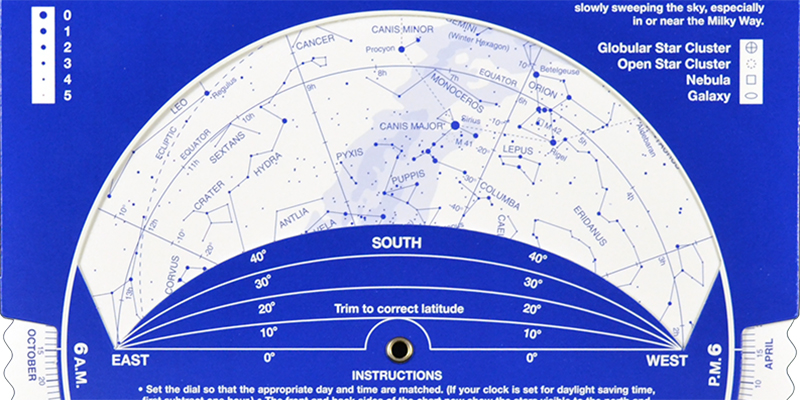About this product
Model: chandler_planisphere_crbd_nh
Part Number: CBNSNH
Generally regarded as the BEST planisphere!
This economical cardboard version of the David Chandler planisphere is a quick and convenient way of seeing which constellations are above the horizon at any specified time and day of the year.
Sky and Telescope magazine adopted The David Chandler 'Night Sky' planisphere in 1976 and has promoted it ever since. It is widely recognised by the amateur astronomy and educational communities as the best planisphere on the market.
Eliminates over 90% of the distortion inherent in conventional one-sided planispheres.
"Chandler's planisphere (rotating star-finder wheel) is the finest available" Sky News
Cardboard Version:
Cardboard versions of The Night Sky™ planisphere feature the same low-distortion, two-sided map projection as our plastic versions. The overall dimensions are 9″h x 8.5″ wide and feature a full sized 8″ diameter map.
The cardboard version is priced lower, but still exhibits superior durability. We have heard from owners who have been using the same cardboard version for twenty years! Some users tell us that they prefer the square dimensions and the ability to hole-punch the edge for insertion in a ringed binder.
All versions for the Northern or Southern Hemisphere planisphere are centered at 40° North or South Latitude and the back of the chart includes trim lines that allow for adjustment to the precise local latitude all the way to the equator.
The planispheres for the Tropics are centered at 20° North or South Latitude and also include trim lines to adjust to the local latitude all the way to the equator.

Key features:
- Unlike coffee-table planispheres, The Night Sky is printed with dark stars on a light background, for easy nighttime readability.
- The constellations are drawn simply, emphasising the brighter stars. The constellation patterns were designed in collaboration with the editors of Sky and Telescope magazine.
- Coordinate grid lines are shown without being intrusive. Coordinates are shown because they can be useful for cross referencing with star atlases.
- A selection of deep sky objects for binocular viewing is included. It is important to point out to beginners that the best first telescope is a pair of binoculars. You may already have what it takes to start observing tonight!
- The Night Sky is larger than it looks! The map scale is larger than on similar-size planispheres because the whole sky does not have to be shown on a single map.
Measures approx 6.25 x 5 inches
Southern Hemisphere Version
The Southern Hemisphere version, covers latitudes from 20° South and greater.
Japanese Version
The latitude setting of the Japanese planisphere is 35°N, which will work well for all of Japan. This is not a crude transliteration. Every aspect of the text has been critiqued and rewritten to read naturally in Japanese by two expert amateur astronomers living in Japan. Even the constellation patterns have been altered to better conform with the way they are recognised in Japan. (Sagittarius, for example, is seen as a Teapot by most Americans. However it does not look like a Japanese teapot!)
Spanish Versions
The constellation names remain in the standard Latin, but the rest of the text was carefully translated and reviewed by native speakers from different countries, the goal being “neutral Spanish” for use in all Spanish-speaking countries.
How to use:
With The Night Sky™ you will be up and running and locating constellations within minutes.
Basic Instructions:
- Find the date on the outer edge of the rotating map dial.
- Find the time on the outer edge of the blue mask.
- Rotate the map dial to align the day with the time.
- Use Standard Time for your location. (If in Daylight Savings time, subtract one hour.)
- To view objects in the northern half of the sky:
- Face North and hold the chart upright in front of you so the word “North” on the blue mask is horizontal. Objects near the horizon line on the planisphere will be low in the sky, near the northern horizon.
- Tilt the chart to the right or left when you face East or West so the word “East” or “West” is horizontal.
- To view objects in the southern half of the sky:
- Face South and, without moving the map dial, flip the chart over and hold the chart upright so the word “South” on the blue mask is horizontal. Objects near the horizon line on the planisphere will be low in the sky, near the southern horizon.
- Tilt the chart to the right or left when you face East or West so the word “East” or “West” is horizontal.
Note For Southern Hemisphere Planispheres: The South side is the front, therefore start by facing South, hold the chart upright in front of you so the word “South” on the blue mask is horizontal.
Tip:
To locate an unfamiliar constellation or star, start by finding a bright star or familiar constellation in the sky first. Next locate the object on The Night Sky™ planisphere and find an adjacent constellation in the direction of the new object. Look up and attempt to find the adjacent object in the sky. Keep using nearby constellations or bright stars as stepping stones to help find the object you are seeking.
Customer reviews
FAQ
Please fill in the form below to ask a question.